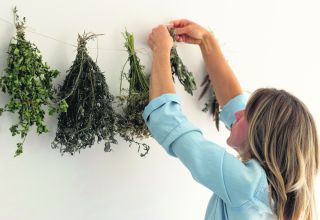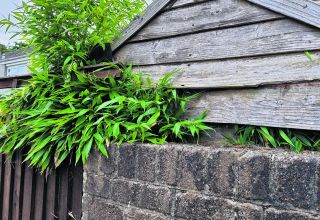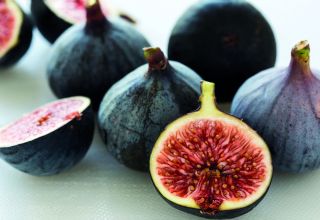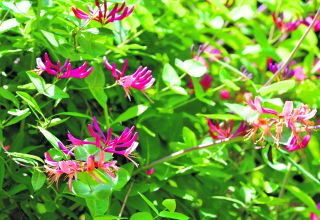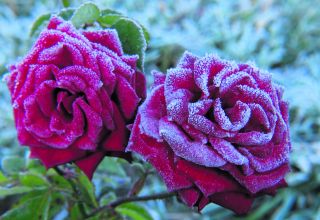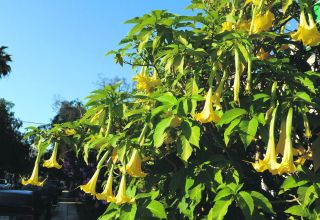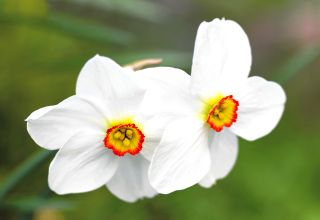
Perhaps the most beautiful of all daffodil varieties and one of the last to appear in the garden these specialist bulbs have become hugely popular in recent years.
What are poet’s daffodils? Also known as poeticus daffodils, poet’s narcissus, or sometimes pheasant’s eye daffodil, poet’s daffodils produce beautiful blooms with pure white petals.
The blooms appear later in the season than most daffodil varieties. They are native to Central Europe, but they have gained popularity with gardeners around the globe. The hardy plants thrive in nearly every corner of the UK. Once planted, poet’s daffodil bulbs will provide beauty for many spring seasons to come.
They have pure white petals that surround a yellow, flattened cup fringed with red.
Easy to grow, it’s a brilliant species for naturalising and growing in long grass, where the intense fragrance that emanates from the flowers will waft on the breeze. A bunch of the cut flowers will easily scent a room indoors.
For best results, grow Narcissus poeticus in full sun or partial shade in moist, well-drained soil. The flowers can be deadheaded, but don’t cut the foliage back until it’s yellow and withered.
Grow poet’s daffodil bulbs about two to four weeks before the ground freezes in the autumn. Nearly any type of moist, well-drained soil is fine, although a raised bed or sloped area is ideal. Fortunately, poet’s daffodil plants tolerate moist winter conditions better than most other varieties. Improve the quality of the soil by digging in a few inches (8 cm.) of well-rotted manure or compost.
Classification and breeding in the 19th century
It was not until the 19th century that classification of the many narcissus species was attempted. Although the name ‘daffodil’ is often applied only to the larger trumpet-flowered cultivars, with the short-cupped and multi-headed cultivars referred to as narcissi, breeders and other enthusiasts refer to all kinds as daffodils.
Due to their popularity as cultivated plants, thousands of cultivars have been bred. The perianths (petals) are mostly yellow or white, but can occasionally be orange, green, or red or a combination of these colours. Today, many cultivars have brightly coloured coronas (cups) which may be yellow, white, pink, orange, red, green or a combination of these.
After care of daffodils is the real key
Remove daffodil blooms as soon as they fade, otherwise the bulbs will exert considerable energy attempting to create seeds.
However, remove only the bloom and stem, not the leaves.
This is the critical aspect of daffodil care after they bloom.
Why do we leave the unsightly foliage in place? In simple terms, the leaves absorb energy from sunlight, and through the process of photosynthesis, the energy is converted into chemicals that produce sugar — the food that keeps bulbs blooming year after year.
If you remove the foliage too early, the bulbs will be stunted, which results in smaller and fewer blooms in the following year.
This also explains why daffodils should be planted in bright sunlight. If your daffodils are planted in partial or full shade and they don’t produce big, healthy blooms, you might want to dig them and move them to a sunnier location after the foliage dies down.
Leave the foliage in place until it dies down and turns yellow. Usually, this takes about six weeks. If the appearance of the dying foliage is driving you crazy, don’t braid the leaves or bunch them in rubber bands, which reduces the amount of sunlight available to the leaves. Instead, consider ways to camouflage the leaves.
For example, plant perennial plants that will hide the dying foliage as they grow in spring.
Provide a handful of bulb fertiliser or any general-purpose fertiliser when shoots poke through the ground in early spring.
Be sure to fertilise the soil around the daffodil plant, but keep the fertiliser off the foliage. Divide daffodils every three to five years, or whenever you notice that flowers are smaller in size or number.
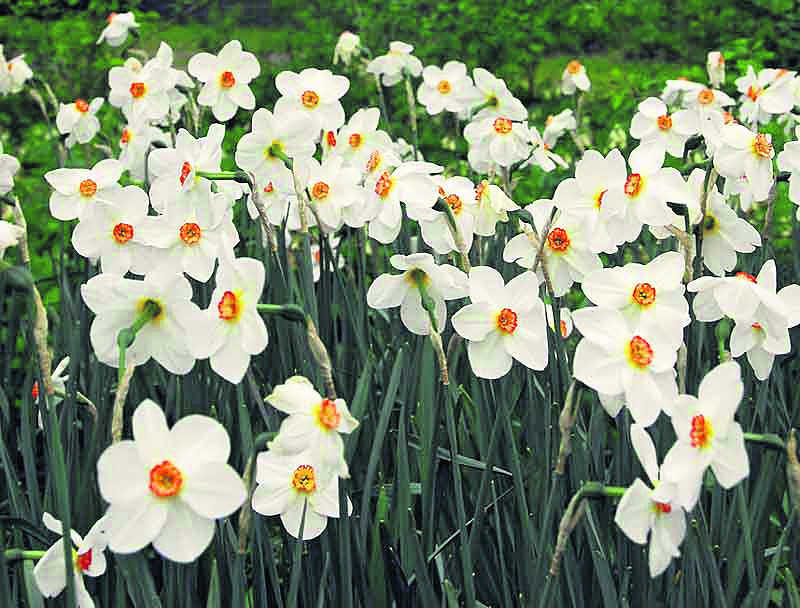
The history of the daffodil
The word ‘Narcissus’ from Greek mythology. A nymph called Echo fell in love with a young Greek named Narcissus, but Narcissus told her to leave him alone. Heartbroken, she lived alone until nothing but an echo of her remained. Nemesis, the God of revenge, heard the story and lured Narcissus to a pool. Narcissus, who was very handsome and quite taken with himself, saw his reflection in the pool and, as he leaned over to see better, fell in and drowned.
He turned into the flower.
Daffodils were introduced into gardens in about 300BC.
Daffodils were brought to Britain by the Romans who thought the sap from daffodils had healing powers. Actually the sap contains crystals that can irritate the skin.
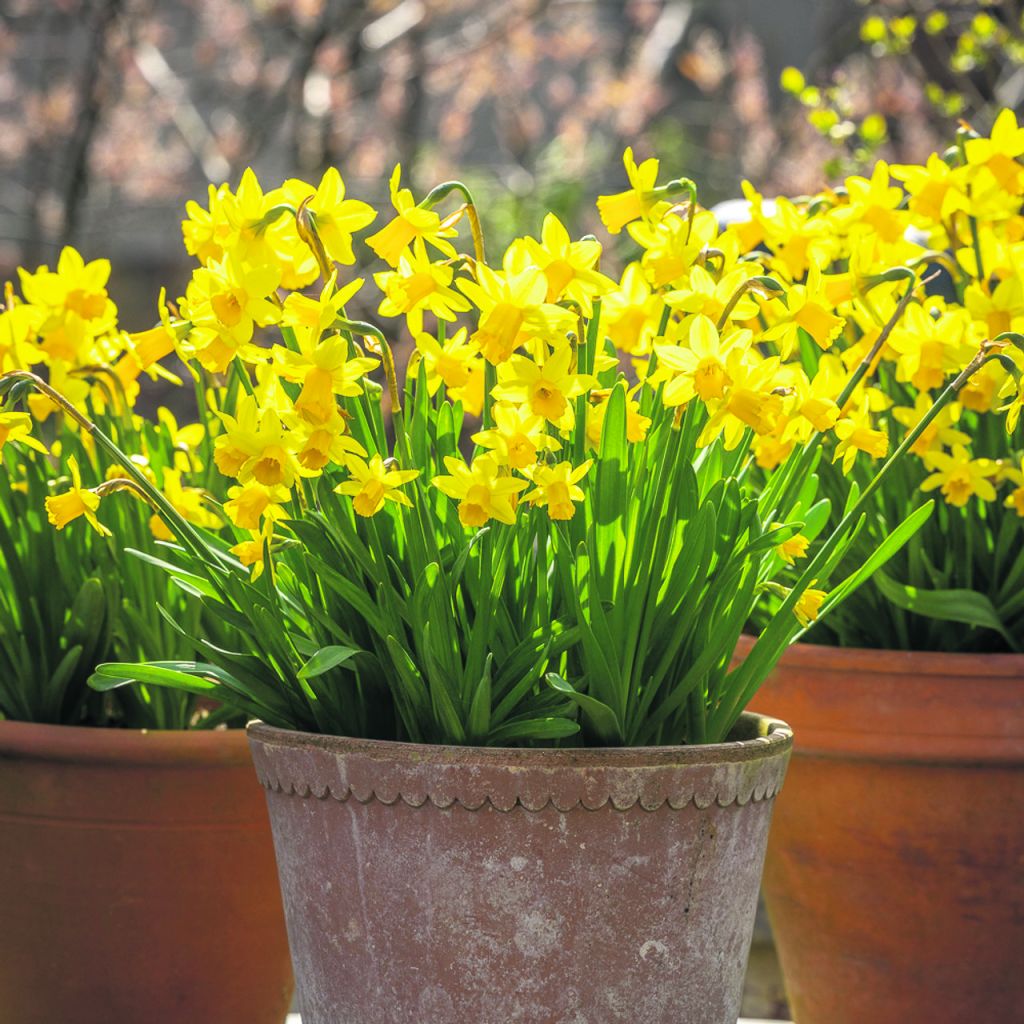
Go miniature
Dwarf daffodil flowers, also known as miniature narcissus, look just like their full-size counterparts. Perfect for rock gardens, naturalised areas, and borders, these bulbs will give you flowers for years if you provide the right conditions and care.
Miniature narcissus is just another name for a dwarf daffodil variety. Like regular-sized daffodils, they grow from autumn planted bulbs and bloom in spring. The size of a dwarf daffodil depends on the variety, but generally they grow four to six inches (10-15 cm.) tall with flowers that are just one and a half inches
(four cm.).
Some mini daffodil varieties to try include:
- Baby Moon: This variety produces cheerful yellow flowers that look like a classic daffodil.
- Hawera: Hawera is an heirloom variety with yellow flowers that hang from the stems like pendants.
- Tete Boucle: For a miniature, double bloom you can’t beat this deep yellow variety.
- Pipit: Pipit will give you multiple, pale yellow, delicate blooms per stem.

